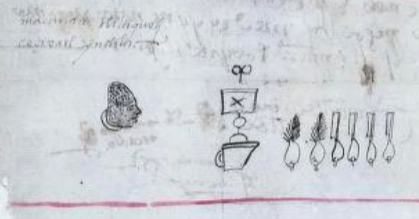tliltic (Osu30v)
This simplex glyph for a black man or woman (tliltic), shows a head in profile, facing toward the viewer’s right. He(?) has a white collar visible and his ears are white. His hair is short, suggested by dots. His hair and skin are painted in a dark gray. The gloss is a demand for five (macuiltin) black men (tliltique) and one black woman (ce çivatl tliltic, which regularizes as ce cihuatl tliltic), who would be working for a Spaniard. Perhaps the person who appears on the same page, who seems to be an “alguacil español,” is expecting this “servicio” (mentioned in the Spanish text).
Stephanie Wood
Black people could be brought to the Americas directly from Africa, from the Atlantic Islands off Iberia, or from the Caribbean. The people mentioned in association with this glyph are not said to be enslaved and this man does not obviously wear the yoke of enslaved people (see below). But, chances are they were in fact enslaved. In this period, they were not likely of the plantation labor class, but rather of the type who were like servants, attached in small numbers to Spaniards, sometimes even working as estate managers. Here, however, they were probably working in a kind of personal service.
Stephanie Wood
1551–1565
Jeff Haskett-Wood
negros, negras, trabajadores, servicio, repartimiento

tliltic, a black person or something black, https://nahuatl.wired-humanities.org/content/tliltic
-tic, a suffix for adjective-like substantives, https://nahuatl.wired-humanities.org/content/tic-0
el negro
Stephanie Wood
Library of Congress Online Catalog and the World Digital Library, Osuna Codex, or Painting of the Governor, Mayors, and Rulers of Mexico (Pintura del Gobernador, Alcaldes y Regidores de México), https://www.loc.gov/resource/gdcwdl.wdl_07324/. The original is located in the Biblioteca Nacional de España.
"The Library of Congress is unaware of any copyright or other restrictions in the World Digital Library Collection. Absent any such restrictions, these materials are free to use and reuse." But please cite the Biblioteca Nacional de España and this Visual Lexicon of Aztec Hieroglyphs if you use any of these images here or refer to the content on this page, providing the URL.







